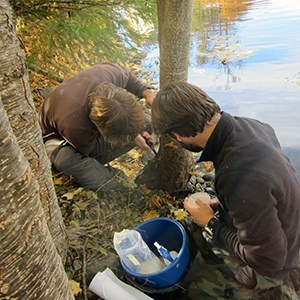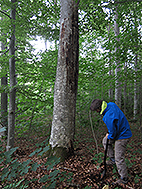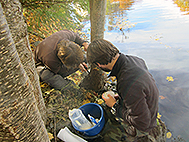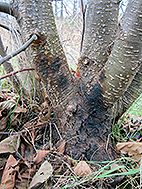The most aggressive pathogen on alder in Sweden, the oomycete Phytophthora alni alni, is so far mostly restricted to the most southern parts of the country. However, the limiting factor to its spread appears to be the cold nights and long-lasting frost of winter. When these will recede north as the climate change, the parasite is assumed to follow. Since the trees apparently does not have the genetic potential to adapt to the pathogen, infected alder trees are expected to increase in the coming decades. So says Miguel Angel Redondo, author of a new thesis from the Department of Forest Mycology and Plant Pathology at SLU.
An imported invasive species
- Both alni alni and alni uniformis are invasive species, Miguel says. They arrived in Sweden recently, and we brought them here by ourselves. Unfortunately, they are here to stay.
In his thesis, Miguel studied the distribution pathways of various Phytophthora species by comparing species richness in nurseries, parks, planted forests and natural forests. He found the most species in nurseries and fewest in natural woodlands, i.e., a strong correlation between the hand of man and Phytophthora presence.
- We believe that imported plant material, in particular to nurseries, is an important gateway for these species and thus also for P. alni. In other words, we have in effect payed to have them here. From the nurseries, they have subsequently spread into natural ecosystems.
Night frost a protection
Miguel and his colleagues also investigated the spread of the two Swedish subspecies, alni and uniformis.
- We have searched for infected alder trees in sixteen Swedish rivers, from Gävleån in the North to Kävlingeån in the South, and investigated which species is causal to the attack. P. alni uniformis was encountered throughout the country, whilst P. alni alni was only discovered in the southern and coastal parts.
The scientists believe that alni is more sensitive than uniformis to cold winters and long-lasting night frost, and thus has not been able to establish further north – so far.
- Naturally, there is a risk that the pathogen will migrate north if, or rather when, the mean temperature rises and the winters grow shorter, Miguel says.
Poor adaptability
Since P. alni alni is known as the more aggressive of the two, this scenario bodes ill for the future of alder. Miguel wanted to investigate the trees potential to adapt to the two pathogens. He collected alder seeds from areas attacked by the respective pathogen and from comparable un-attacked areas, grew them and subsequently infected the seedlings.
- The idea was that uninvaded areas symbolize the tree population before the arrival of the parasite. If the trees have adapted to the attacks, the most sensitive trees should be gone in the invaded areas, which thus should display a higher mean resistance.
The results showed that this was true for uniformis; the forests that was not invaded had not gone through any adaptation and had more susceptible individuals. This was however not the case for alni; invaded and uninvaded areas had the same mean level of resistance.
- This shows that alder does not have a strong genetic component for resistance against P. alni alni, and thus will be harder pressed to adapt to this pathogen than to P. alni uniformis. This obviously means that the future expansion of this species is even more ill-boding for the alder, Miguel finishes.




